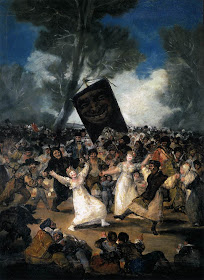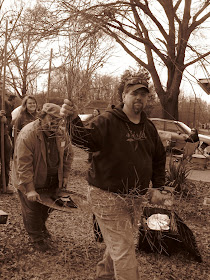 |
Francisco Goya - The Burial of the Sardine |
One of the many things I enjoy about sardines are the traditions and customs that are held by so many different cultures. While Ambrosia may be held as the food of the Gods, sardines could be said to be the food of men. Sardines can be enjoyed by all, no matter locale, race, finance-- it's truly a food for all.
One such tradition is El Entirrro de la Sardina (The Burial of The Sardine), a Spanish tradition of burying or burning a fish. A sardine at that!
The ceremony of the burial of the sardine is usually a mock burial procession through town while an effigy of a sardine or real sardine is carried for all to see and mourn, in a real or make shift coffin. People dressed in costumes and mourning attire fill the streets, with fake screams and weeping. The location of the town often times seals the fate of the Sardine. Those next to shorelines burn the sardine and then throw the ashes into the sea. The town's people some times even carry the ashes out to be scattered into the sea symbolizing the sardine's return home. In landlocked towns, the sardine is often times buried. (Burn and bury is practiced the same despite location.) These ceremonies are often times followed by large displays of fireworks, representing the end of Carnival. In some areas the celebration is held on Ash Wednesday, yet in other towns this ceremony takes place the first Saturday after Easter.
Like most traditions, no one can truly lay claim to the origin of it. There are many explanations.
1. The event goes back to pre-Christian times. It is a pagan fertility custom symbolizing the burial of winter in early spring; spring awakes and brings a new year of life to nature. It is the symbolic burial of the past to allow society to be reborn, transformed and with new vigor. (The burning of the dead was not allowed by Christians in ancient times because it was seen as strictly a pagan practice and was even made illegal by the church. Burning the sardine would have came from pagan roots).
2. In the 18th century, Charles III (king of Spain) wanted to celebrate the end of Carnival with the commoners. He ordered sardines, but when the shipment arrived, all the sardines were spoiled. The people buried the sardines due to the odor. The commoners mourned the thought of burying free food. Another version has it that the sardines that came in for Lent were spoiled, and that King Charles III, irate that they were spoiled, had them buried/burned. This morphed into a tradition of burying of the sardine.
3. A breed of pig called "sardine" was buried, which represented Sin and symbolized the excesses during Carnival; burial of a pig in representation of the meat Catholics would have to forfeit eating during the religious observation period.
5. The custom symbolizes the burial of worldly pleasures and serves as a reminder that people must abstain from eating meat on Fridays throughout the 40 days of Lent; it's a symbol to celebrate the end of eating so much fish; it symbolizes abstinence and fasting; it represents the Catholic repentance at the pagan excesses of the Carnival; a sardine is buried to bring luck to all the fisherman who will be catching and supplying fish to everyone during the 40 days of meatless Lent.
6. It only dates back to 1850, when a group of students decided to form an entourage presided over by a sardine, symbolizing fasting and abstinence, after Carnival.This celebration is held all over Spain, in many different styles and for many different reasons, yet the sardine remains the center of attention.
Just before Ash Wednesday I attended a community function where we built bee houses for our local native bee population. I figured this would be a good time to do a Burial of the Sardines ceremony, (since we were doing a community project and all) So, in Mouth Full of Sardines fashion, I give you the Burial of the Sardines.
The tin of fish, resting upon its velvet, sitting on its brass tray, waiting for the burial.


Our procession, led by Raven, was started off in a "Wicker Man" fashion. Kathleen runs over and grabs large bamboo poles for the procession.
To represent burying the winter for a new spring, we have winter and a little spring carrying the sardines.
We passed the tin around, telling the fish what we would like to change, get rid of, and to start anew.
Tony gazes upon the tin of fish.
I don't think Kathleen is a sardine eater (or Tony).
I don't think Kathleen is a sardine eater (or Tony).
As the tin went around

Eric taking a big whiff of the badly smoked tin of fish.
We buried the fish in some leaves.
Stewart was more than eager to light the ceremonial Sardine fire.
Ah, now the sardines are truly smoked. They were paraded, passed around, buried and burned.
Perhaps I need to write up a sardine song for everyone to sing as the sardines burn. Next year, next year...
A big thank you to every one who participated in the burial of the sardine ceremony. No one called me crazy. I believe some non-sardine eaters gained some respect for the sardine. Next year, the ceremony could take place at a community project near you.
If there are any sardine eaters that are musically inclined, feel free to send in your sardine burial songs for next year's ceremony. If we receive 50 songs, we'll sing 50 songs at next year's burial.



















LOL!!!! Love it!!! ^_^
ReplyDeleteGreat Ceremony!! Is that a tin of Van Camp Chicken of the Sea, Lightly Smoked in oil?
ReplyDeleteNo, its not Van Camps/chicken of the sea. Good try.
Deleteenjoyed the history and ceremony
ReplyDeleteFeel free to guess as many times as you like.
ReplyDeleteThose sardines look like Polar brand from China. Water or oil. Seed the earth with salt so those nasties don't come back!!!
ReplyDeleteNo, not polar
DeleteIs it a can of the smoked Pampa sardines? I've had their smoked oysters and it looks similar
ReplyDeleteNo, not Pampa.
Delete